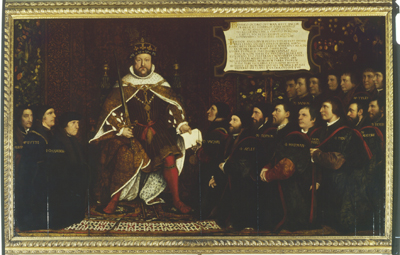A Venetian ambassador to London described the young Henry VIII as “the handsomest potentate I ever set eyes on ... his complexion very fair and bright, with auburn hair combed straight in the French fashion; and a round face so beautiful that it would become a pretty woman, his throat being rather long and thin...” The Young Henry VIII, painted by an anonymous English court artist in around 1513, is exhibit 43 of 275 in the British Library’s sprawling new exhibition, “Henry VIII: Man and Monarch”. The picture is by no means a masterpiece, but it conveys something of the surprising delicacy noted by the young king’s contemporaries. He wears his hair in an effeminate mop, loose strands pinned into place by great bejewelled clasps. Between thumb and forefinger of his right hand he holds a rose, symbol of the Tudor dynasty. His skin is porcelain pale and he has a faraway look in his eyes.
Guest-curated by David Starkey, the British Library’s exhibition marks the five hundredth anniversary of Henry VIII’s accession to the throne. Starkey is known as a popular historian, but despite the window-dressing of a ready-to-mount virtual jousting machine – complete with video-enabled visor – this is a heavyweight historical show. The emphasis, throughout, is on primary textual sources, so that for long stretches most of the exhibits take the form of manuscripts, letters and legal documents. In fact, one of the revelations of the display is the inverse relationship between Henry’s growing autocratic ruthlessness and his ever-increasing obsession with legal technicalities. Not content with breaking his Coronation Oath, Henry amended the actual document itself after the fact, as if to change the laws that he himself had violated. Such scribblings might look naive and clumsy, but it was through those crossings-out that England...
Guest-curated by David Starkey, the British Library’s exhibition marks the five hundredth anniversary of Henry VIII’s accession to the throne. Starkey is known as a popular historian, but despite the window-dressing of a ready-to-mount virtual jousting machine – complete with video-enabled visor – this is a heavyweight historical show. The emphasis, throughout, is on primary textual sources, so that for long stretches most of the exhibits take the form of manuscripts, letters and legal documents. In fact, one of the revelations of the display is the inverse relationship between Henry’s growing autocratic ruthlessness and his ever-increasing obsession with legal technicalities. Not content with breaking his Coronation Oath, Henry amended the actual document itself after the fact, as if to change the laws that he himself had violated. Such scribblings might look naive and clumsy, but it was through those crossings-out that England...


